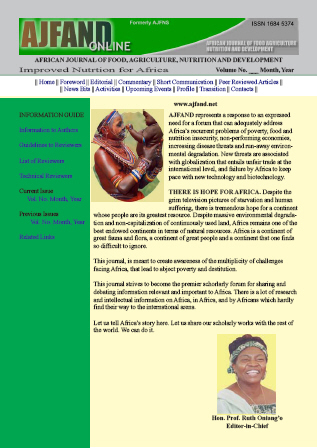
|
African Journal of Food, Agriculture, Nutrition and Development
Rural Outreach Program
ISSN: 1684-5358
EISSN: 1684-5358
Vol. 20, No. 4, 2020, pp. 16085-16098
|
 Bioline Code: nd20057
Bioline Code: nd20057
Full paper language: English
Document type: Research Article
Document available free of charge
|
|
|
African Journal of Food, Agriculture, Nutrition and Development, Vol. 20, No. 4, 2020, pp. 16085-16098
| en |
FINANCIAL PERFORMANCE AND CONSTRAINTS IN GARI PRODUCTION IN KUMASI, GHANA
Nimoh, F; Richmond Anaman, R; Asiamah, MT; Yeboah, B; Agyekum, I; Kpe, PDK & Kouao, DK
Abstract
Gari is a crisp and crunchy West African food made from grated cassava with the excess
liquid dried out. It is a major food security product consumed by most households and
students in second cycle institutions in West African. Gari production is an important
source of livelihood for many women in the informal sector in Ghana. It serves as a vital
avenue for value addition to cassava, thus helping to address the problem of post-harvest
losses and generating income for producers. This study assessed the financial
performance and constraints in gari production in Kumasi, Ghana. Primary data from a
cross-sectional survey of 46 gari producers who were identified using snowball sampling
technique was used. Descriptive statistics, profitability indicators, and a 5-point Likert
scale were used to analyse the primary data. Results showed that gari production is
predominantly done by women 30-75 years old with a mean age of 50 years. Majority of
producers had no formal education (57%) and had been in production for an average of
24 years. It was found that gari production in Kumasi is financially profitable, with all
the profitability indicators employed showing positive returns on inputs employed in
production, although the values were less competitive relative to other producers’ values
elsewhere. The profit margin was favourable at 22%, return on capital employed (ROCE)
at 29% and operating expense ratio at 76%. The relatively low ROCE of 29% compared
with the opportunity cost of capital (31%) by commercial banks in the study area
indicates the underutilization of producers’ capital in gari production. Key constraints
identified in the gari production business were seasonality and high cost of cassava.
Adoption of cost-effective management strategies and release of all year round cassava
varieties could help improve gari production and livelihoods of producers and other
actors along the cassava value chain.
Keywords
Cassava; Gari; Production; Profitability; Constraints; Women; Livelihood; Kumasi-Ghana
|
| |
© Copyright 2020 - African Journal of Food, Agriculture, Nutrition and Development
Alternative site location: http://www.ajfand.net/
|
|
